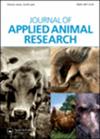Seroprevalence of brucellosis in dairy animals and their owners in selected sites, central highlands of Ethiopia
IF 1.3
4区 农林科学
Q3 AGRICULTURE, DAIRY & ANIMAL SCIENCE
引用次数: 0
Abstract
A cross-sectional study was conducted from December 2019 to May 2020 to determine the seroprevalence and identify potential risk factors of brucellosis in dairy cows and owners. Purposive sampling was performed in the respective farms and kebeles to screen recent cases of abortion. The overall seroprevalence of bovine and human brucellosis was 0.61% (95%CI:0.016–2.09) and 1.21% (95%CI:0.032–4.27) respectively using combined RBPT and CFT tests. Late stage of abortion (OR = 14.74, p = 0.0002), retained fetal membrane (OR = 32.74, p = 0.006), market-based stock replacement (OR = 16.55, p = 0.002), and presence of parturition pen (OR = 11.511, p = 0.027) was found to be significantly associated with seropositivity for Brucella infection in dairy cattle. Human housing (OR = 1.8, p = 0.002), contact with aborted fetus (OR = 21.19, p = 0.017), and drinking raw milk from aborted (OR = 5.72, 0.019) and retained fetal membrane (OR = 4.22, p = 0.029) cows all had a significant influence on human brucellosis seropositivity. A structured interview question was administered to 284 respondents. Accordingly, most respondents had no knowledge of bovine brucellosis and their zoonotic effects (93.3%) in contrast most of them drink raw milk. Implementation of a test and slaughter strategy with compensation is recommended with this low prevalence. In the case of human brucellosis, implementing one health approach framework should be practiced.埃塞俄比亚中部高地选定地点奶牛及其饲主的布鲁氏菌病血清流行率
2019年12月至2020年5月进行了一项横断面研究,以确定奶牛和奶牛主人的布鲁氏菌病血清阳性率并确定潜在危险因素。在各自的农场和卫生院进行了有目的的抽样,以筛查最近的堕胎病例。采用RBPT和CFT联合检测,牛和人布鲁氏菌病的总血清阳性率分别为0.61% (95%CI: 0.016-2.09)和1.21% (95%CI: 0.032-4.27)。流产后期(OR = 14.74, p = 0.0002)、胎膜残留(OR = 32.74, p = 0.006)、市场置换(OR = 16.55, p = 0.002)和产房栏存在(OR = 11.511, p = 0.027)与奶牛布鲁氏菌感染血清阳性显著相关。人的居住环境(OR = 1.8, p = 0.002)、接触流产胎(OR = 21.19, p = 0.017)、饮用流产牛(OR = 5.72, 0.019)和残留胎膜(OR = 4.22, p = 0.029)的生乳对人布鲁氏菌病血清阳性均有显著影响。对284名受访者进行了结构化访谈。因此,大多数应答者不了解牛布鲁氏菌病及其人畜共患效应(93.3%),相比之下,大多数应答者饮用生奶。鉴于这种低流行率,建议实施带有补偿的检测和屠宰策略。就人类布鲁氏菌病而言,应实行一种卫生方针框架。
本文章由计算机程序翻译,如有差异,请以英文原文为准。
求助全文
约1分钟内获得全文
求助全文
来源期刊

Journal of Applied Animal Research
农林科学-奶制品与动物科学
CiteScore
2.70
自引率
0.00%
发文量
80
审稿时长
6 months
期刊介绍:
Journal of Applied Animal Research (JAAR) is an international open access journal. JAAR publishes articles related to animal production and fundamental aspects of genetics, nutrition, physiology, reproduction, immunology, pathology and animal products. Papers on cows and dairy cattle, small ruminants, horses, pigs and companion animals are very welcome, as well as research involving other farm animals, aquatic and wildlife species. In addition, manuscripts involving research in other species that is directly related to animal production will be considered for publication.
 求助内容:
求助内容: 应助结果提醒方式:
应助结果提醒方式:


